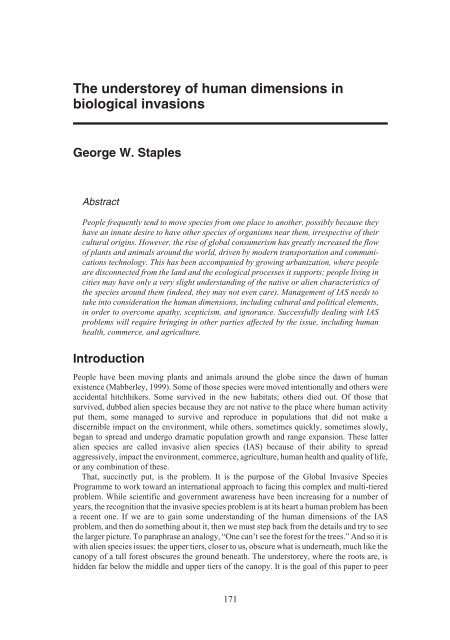Alien Species.vp - IUCN
Alien Species.vp - IUCN
Alien Species.vp - IUCN
You also want an ePaper? Increase the reach of your titles
YUMPU automatically turns print PDFs into web optimized ePapers that Google loves.
The understorey of human dimensions in<br />
biological invasions<br />
George W. Staples<br />
Abstract<br />
People frequently tend to move species from one place to another, possibly because they<br />
have an innate desire to have other species of organisms near them, irrespective of their<br />
cultural origins. However, the rise of global consumerism has greatly increased the flow<br />
of plants and animals around the world, driven by modern transportation and communications<br />
technology. This has been accompanied by growing urbanization, where people<br />
are disconnected from the land and the ecological processes it supports; people living in<br />
cities may have only a very slight understanding of the native or alien characteristics of<br />
the species around them (indeed, they may not even care). Management of IAS needs to<br />
take into consideration the human dimensions, including cultural and political elements,<br />
in order to overcome apathy, scepticism, and ignorance. Successfully dealing with IAS<br />
problems will require bringing in other parties affected by the issue, including human<br />
health, commerce, and agriculture.<br />
Introduction<br />
People have been moving plants and animals around the globe since the dawn of human<br />
existence (Mabberley, 1999). Some of those species were moved intentionally and others were<br />
accidental hitchhikers. Some survived in the new habitats; others died out. Of those that<br />
survived, dubbed alien species because they are not native to the place where human activity<br />
put them, some managed to survive and reproduce in populations that did not make a<br />
discernible impact on the environment, while others, sometimes quickly, sometimes slowly,<br />
began to spread and undergo dramatic population growth and range expansion. These latter<br />
alien species are called invasive alien species (IAS) because of their ability to spread<br />
aggressively, impact the environment, commerce, agriculture, human health and quality of life,<br />
or any combination of these.<br />
That, succinctly put, is the problem. It is the purpose of the Global Invasive <strong>Species</strong><br />
Programme to work toward an international approach to facing this complex and multi-tiered<br />
problem. While scientific and government awareness have been increasing for a number of<br />
years, the recognition that the invasive species problem is at its heart a human problem has been<br />
a recent one. If we are to gain some understanding of the human dimensions of the IAS<br />
problem, and then do something about it, then we must step back from the details and try to see<br />
the larger picture. To paraphrase an analogy, “One can’t see the forest for the trees.” And so it is<br />
with alien species issues: the upper tiers, closer to us, obscure what is underneath, much like the<br />
canopy of a tall forest obscures the ground beneath. The understorey, where the roots are, is<br />
hidden far below the middle and upper tiers of the canopy. It is the goal of this paper to peer<br />
171












